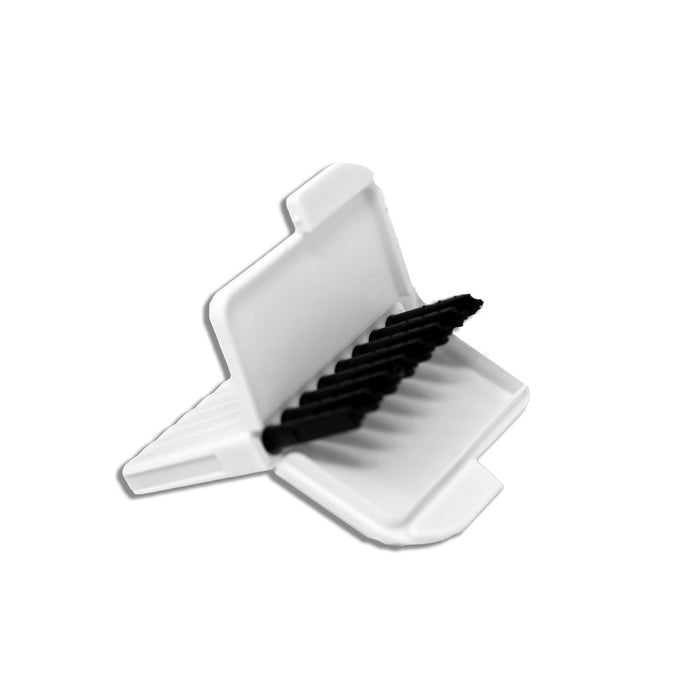
Signia Wax Guards for MiniReceiver Wires
Discover the game-changing wax guards that will revolutionize your sound experience. Say goodbye to muffled audio and hello to crystal-clear perfection! Click now for the secret!
Revolutionary Wax Guards: The Secret to Perfect Sound
Introducing Revolutionary Wax Guards: The Secret to Perfect Sound.
In the realm of hearing aids, achieving optimal sound quality is paramount. This is where wax guards play a crucial role. Engineered exclusively for hearing aids utilizing the Signia MiniReceiver 2.0, the Signia Wax Guards have emerged as a game-changer. With an impressive rating of 4.80 out of 5 based on 5 customer reviews, they have gained the trust of users worldwide.
To maintain peak performance, it is recommended to replace wax guards every 2-3 weeks, although this may vary depending on individual use and earwax buildup. By monitoring earwax production and changing the wax filter when there is visible buildup or a decline in sound quality, users can ensure exceptional functionality.
These wax guards are user-friendly, featuring a simple 2-step removal and insertion process, lightweight design, and portability.
Specially designed for the Signia MiniReceiver wire, these wax guards are compatible with various hearing aid brands, including Signia, Siemens, Specsavers Advance, and Audio Service. Additionally, a convenient carry case is provided for both new and used wax guard sticks.
With their ergonomic shape and remarkable ability to optimize hearing aid performance, these wax guards truly revolutionize the listening experience.
Key Takeaways
- Signia Wax Guards are designed for Signia MiniReceiver 2.0 hearing aids and have received high ratings and positive reviews from users worldwide.
- Regularly replacing wax guards every 2-3 weeks ensures clear and natural sound by preventing wax accumulation and obstruction of sound transmission.
- The wax guards are compatible with leading hearing aid brands, making them a convenient and user-friendly solution for various hearing aid models.
- Using wax guards provides long-lasting protection for hearing aids, extends their lifespan, and saves money on repairs and maintenance.
The Importance of Regular Wax Guard Replacement
Regular wax guard replacement is essential for maintaining optimal sound quality in hearing aids. Wax guards are designed to prevent earwax from entering the receiver and clogging the sound outlet, which can significantly impact the performance of the device.
Over time, wax can accumulate on the guard, obstructing sound and causing distortion. By changing the wax guard every 2-3 weeks, users can ensure that their hearing aids continue to deliver clear and natural sound. The frequency of wax guard replacement may vary based on individual earwax production and usage patterns.
It is important to monitor the condition of the wax guard and change it when there is visible build-up or a decline in sound quality. Regular wax guard replacement is a simple and effective way to maintain the proper functioning of hearing aids and enhance the overall hearing experience.
How Often Should Wax Guards Be Changed
To maintain optimal sound quality in hearing aids, it is important to determine the frequency at which wax guards should be changed. Wax guards should typically be changed every 2-3 weeks, but this can vary depending on personal use and the amount of earwax build-up.
It is crucial to monitor earwax production and change the wax guard when there is visible build-up or when the sound quality starts to decline. Before inserting a new wax guard, it is recommended to clean the area around the filter to ensure proper functioning.
The Signia Wax Guards for MiniReceiver Wires are specifically designed for Signia hearing aids and provide a simple 2-step removal and insertion process. By following these guidelines, users can ensure that their hearing aids continue to deliver the perfect sound they desire.
Signs That It's Time to Change Your Wax Guard
When determining whether it is time to change your wax guard, it is important to look for specific signs that indicate the need for replacement. Here are four key signs to watch out for:
1. Reduced sound quality: If you notice a decline in the quality of sound produced by your hearing aids, it may be a sign that your wax guard needs to be changed. Wax build-up can block the sound from reaching your ears effectively.
2. Difficulty hearing: If you find it harder to hear conversations or sounds that you could previously hear clearly, it could be a result of wax accumulation in your wax guard. Changing the wax guard can help restore your hearing ability.
3. Visible wax build-up: Take a look at your wax guard and check for any visible wax build-up. If you see a significant amount of wax, it's time to replace the guard.
4. Feedback or whistling sounds: If you experience feedback or whistling sounds coming from your hearing aids, it may be due to a blocked wax guard. Changing the guard can help eliminate these unwanted noises and improve your listening experience.
Proper Cleaning Techniques for Wax Guard Maintenance
To ensure optimal performance and longevity of your wax guard, it is essential to employ proper cleaning techniques for its maintenance. Cleaning the wax guard regularly helps to remove any accumulated earwax and debris, ensuring that it does not obstruct sound transmission.
Start by removing the wax guard from the hearing aid using the appropriate tool provided. Gently clean the wax guard using a soft cloth or brush, being careful not to damage the delicate mesh.
It is important to avoid using water or cleaning agents, as they may cause damage to the wax guard. Once the wax guard is clean, carefully reinsert it into the hearing aid.
Step-by-Step Guide on How to Insert a New Wax Guard
To ensure proper functionality of your hearing aids, it is essential to know the step-by-step process of inserting a new wax guard. Follow these simple instructions to effectively insert a new wax guard for your hearing aids:
1. Remove the used wax filter: Use the black tip of the wax guard stick to gently remove the old wax filter from the receiver. Check for any excess earwax and clean the area before proceeding to the next step.
2. Prepare the new wax guard: Take the white tip of the wax guard stick and firmly press it into the receiver. Ensure that the new wax guard is securely in place to prevent any sound quality issues.
3. Monitor earwax production: Keep an eye on the build-up of earwax and change the wax guard every 2-3 weeks or when there is visible build-up. Regularly cleaning the area around the filter before inserting a new one will help maintain optimal sound quality.
4. Enjoy perfect sound: By regularly replacing the wax guard, you can ensure that your hearing aids continue to function at their best, providing you with the perfect sound experience you deserve.
Compatible Hearing Aids for Signia Wax Guards
The compatibility of Signia Wax Guards extends to a range of hearing aids, including those from Signia, Siemens, Specsavers Advance, and Audio Service, ensuring optimal performance for a variety of users. These wax guards are specifically designed for Signia MiniReceiver wires, making them suitable for use with a wide range of hearing aids that utilize this technology.
By using the Signia Wax Guards, users can effectively protect their devices from wax build-up, ensuring clear and uninterrupted sound quality. The lightweight and portable design, along with the simple 2-step removal and insertion process, make it convenient for users to maintain the cleanliness and functionality of their hearing aids.
With the compatibility of Signia Wax Guards, users can experience the benefits of these revolutionary products with their preferred hearing aid brands.
Key Features and Benefits of Signia Wax Guards
Continuing from the previous subtopic, the unparalleled compatibility of Signia Wax Guards extends to a range of hearing aids, ensuring optimal performance for a variety of users.
Here are the key features and benefits of Signia Wax Guards:
1. Lightweight and portable: Signia Wax Guards are designed to be lightweight and easy to carry, making them convenient for on-the-go use.
2. Simple 2-step removal and insertion process: With a black tip for removing used wax filters and a white tip for inserting new wax guards, Signia Wax Guards offer a hassle-free experience.
3. Ergonomic shape for good grip: The wax guard sticks are ergonomically designed to provide a comfortable and secure grip during the removal and insertion process.
4. Ensures proper functioning of hearing aids: By preventing wax build-up, Signia Wax Guards help maintain the optimal performance of your hearing aids, ensuring clear and uninterrupted sound quality.
With these features and benefits, Signia Wax Guards are a must-have accessory for anyone using Signia, Siemens, Specsavers Advance, or Audio Service hearing aids.
Frequently Asked Questions
Can the Signia Wax Guards Be Used With Hearing Aids From Other Brands?
Yes, the Signia wax guards are compatible with hearing aids from other brands such as Siemens, Specsavers Advance, and Audio Service. They are specifically designed for use with the Signia MiniReceiver wire.
Is It Possible to Clean and Reuse the Signia Wax Guards?
No, the Signia wax guards are designed for single-use only and cannot be cleaned and reused. It is recommended to change the wax guards every 2-3 weeks or when there is visible build-up or decline in sound quality.
Are the Signia Wax Guards Compatible With All Signia Minireceiver Wires?
Yes, the Signia wax guards are compatible with all Signia MiniReceiver wires. They are specifically designed for Signia hearing aids and ensure proper functioning by preventing earwax build-up and maintaining sound quality.
How Long Does It Take to Change the Signia Wax Guard?
The process of changing the Signia wax guard typically takes a few minutes. It involves removing the old wax filter using the black tip of the wax guard stick and securely placing the new wax guard with the white tip into the receiver.
Are There Any Side Effects or Discomfort Associated With Using the Signia Wax Guards?
There are no known side effects or discomfort associated with using Signia wax guards. They are designed to ensure proper functioning of hearing aids and provide a simple and efficient solution for managing earwax build-up.
Conclusion
In conclusion, Signia Wax Guards offer a revolutionary solution for maintaining optimal sound quality in hearing aids. With their user-friendly design and compatibility with various brands, these wax guards are trusted by users worldwide.
By regularly monitoring earwax buildup and replacing the wax filters as needed, users can ensure peak performance. With the provided carry case for convenience and organization, these wax guards are truly a game-changer in the world of hearing aids.


